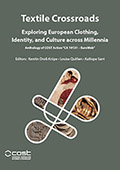Center, Textile Research

Textile Crossroads: Exploring European Clothing, Identity, and Culture across Millennia
Date of this Version
2024
Document Type
Article
Citation
In Textile Crossroads: Exploring European Clothing, Identity, and Culture across Millennia. Anthology of COST Action “CA 19131 – EuroWeb”. Kerstin Droß-Krüpe, Louise Quillien, & Kalliope Sarri, Editors. Zea Books, Lincoln, Nebraska, 2024. DOI: 10.32873/unl.dc.zea.1805
Abstract
The production of textiles, in terms of weaving techniques, has a long history in Europe, and dates back to the Stone Age, the time during which the first farming communities arrived in the Mediterranean and Central Europe, in the 7th/6th millennium BC. The first evidence of textile tools, like spindle whorls and loom weights, demonstrate that people made an important step forward in mechanizing this craft, not only twisting fibers and interlacing strands purely by hand, but also inventing tools to increase efficiency. Through the development of textile techniques, we see the unleashing of enormous creative power that stimulated even more advanced techniques to create specific structures and patterns — these still form an important part of our European cultural heritage, which was also studied with the COST Action Euro Web. As an example, the art of blue dyeing has been listed by UNESCO as an example of Intangible Heritage in Austria, Slovenia, Czech Republic, and Slovakia since 2018;1 all over the world, different techniques have been awarded Textile Intangible Cultural Heritage status.2 To preserve craft knowledge for the future, it is important to understand details on ancient weaving techniques. This knowledge might not only be used for research and science communication, but also could potentially be integrated into the daily lives of modern people.
The case studies presented here will centre on the incorporation of gold threads into textiles, a method of decoration which has been found across different time periods and areas in Europe and the Mediterranean.3 In this contribution, we focus on Late Bronze Age contexts, like Ebreichsdorf and Vösendorf in Austria and Óbuda in Hungary, as well as others from the Roman Period, such as Pompeii, Herculaneum, and Oplantis in Italy.
Reconstructing textiles from European archaeological contexts that are thousands of years old is a demanding task. Contrary to other parts of the world, the environmental conditions in most areas of Europe are not conducive to the preservation of organic remains in general, and textile materials in particular.4 In fact, and while exceptions do exist (see below), direct evidence for the textile component of the material worlds of prehistoric and ancient Europe is, for the most part, fragmentary and incomplete.
This being said, there are several different strands of evidence that can be used to achieve empirically grounded scientific reconstructions of the types of textiles used during this period across Europe. The main sources for such reconstructions can be divided into several categories: Archaeological sources (textiles and their scientific analysis, tools); iconographic sources; written sources; ethnographic/folkloristic evidence; and experimental archaeology.
Included in
Ancient History, Greek and Roman through Late Antiquity Commons, Archaeological Anthropology Commons, Classical Archaeology and Art History Commons, Classical Literature and Philology Commons, Eastern European Studies Commons, European History Commons, European Languages and Societies Commons, Fiber, Textile, and Weaving Arts Commons, History of Science, Technology, and Medicine Commons, Human Geography Commons, Museum Studies Commons, Place and Environment Commons, Social and Cultural Anthropology Commons, Women's Studies Commons


Comments
Copyright © 2024 by the authors.